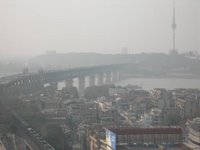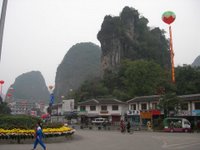Wuhan to Yangshuo
We've made it to Yangshau, a small town south of Guilin in Guizhou province. It's been an eventful few weeks since Shanghai.
From Shanghai, we made our way west to Wuhan, enjoying the hospitality of new friends with whom we stayed at the Central China Normal University.
In Wuhan, I walked across the Yangtze and climbed the Yellow Crane Tower.


From Wuhan, we traveled to Yichang. Our friends in Wuhan had, the previous month, made the trip down the Yangtze from Chongqing to Yichang (the opposite of what we intended) and put us in touch with John in Chongqing from whom they had bought their tickets. Within five minutes talking with Chris on the phone, and before we had agreed to buy tickets, John had invited us to a 'hotpot' lunch when we arrived in Chongqing.
While in Yichang, we visited the Three Gorges Dam Project, a massive construction site set to be completed in 2009, and enjoyed the landscape around Yichang and the nearby dam.
 From Yichang, we took a cruise upstream, through the Three Gorges, to Chongqing, onetime seat of the Kuomintang government during the Second World War. The cruise took three days and nights, arriving early on the fourth day. The boat had mostly Chinese tourists, although there was a small Australian tour group and a Dutch couple whose company we enjoyed. At night, in our small four-berth cabin, we listened to rats scuttle around the room.
From Yichang, we took a cruise upstream, through the Three Gorges, to Chongqing, onetime seat of the Kuomintang government during the Second World War. The cruise took three days and nights, arriving early on the fourth day. The boat had mostly Chinese tourists, although there was a small Australian tour group and a Dutch couple whose company we enjoyed. At night, in our small four-berth cabin, we listened to rats scuttle around the room.

Looking back at the photos we took on trip, they fail to capture the true magnificence and awe inspired by the gorges.


Arriving in Chongqing, we were met by John who, indeed, took us out to lunch. We spent the day in Chongqing, leaving by train that evening for Guilin. We had understood the train journey would take about 14 hours, but upon waking in the morning and not stopping, we discovered the journey would actually take about 22 hours. Nonetheless, the journey, as with our previous overnight train experience, was quite enjoyable. Moving south, the topography changed markedly, as flat planes were replaced by limestone karsts dotting the landscape.

Guilin, on the Li River, is built amongst and around these karst pinnacles. The result is some pretty impressive scenery, even in central Guilin.


From Guilin we traveled north to the town of Pin'an in the mountains near Longshan. This area is famous for the terraced fields which are cut into the sides of the mountains here. Unfortunately, the weather turned cold and rainy and as we climbed higher, we were soon engulfed in thick fog. All of the buildings in Pin'an, a tiny town perched high on the side of a mountain, are made of wood with no insulation. We stayed in a small hotel and our room, had we been able to see through the fog, would have afforded us a spectacular view into the valley bellow. As it was, the view was somewhat unimpressive.

At night we huddled around a charcoal fire with the hotel owner, employees, and a few Chinese guests. It was here, at the hotel, that we met Ah-jei from Yangshuo. The following day, with the weather showing no sign of improving, we took a bus (and hiked a short way to the bus) with Ah-jei to his hometown.

Upon arriving in Yangshuo, Ah-jei insisted we join him and his wife for dinner in their small apartment. The meal was delicious. Yangshuo, like Guilin to the north, is extremely picturesque. It is smaller, though, and feels much more like a relaxed town.

On our second day in Yangshuo, Ah-jei took us to the small village of Xingping an hour north where we took a boat along the Li River to a small fishing village. We hiked back along the river before returning to Yangshuo where we again joined Ah-jei and his wife for dinner at their apartment.





0 Comments:
Post a Comment
<< Home